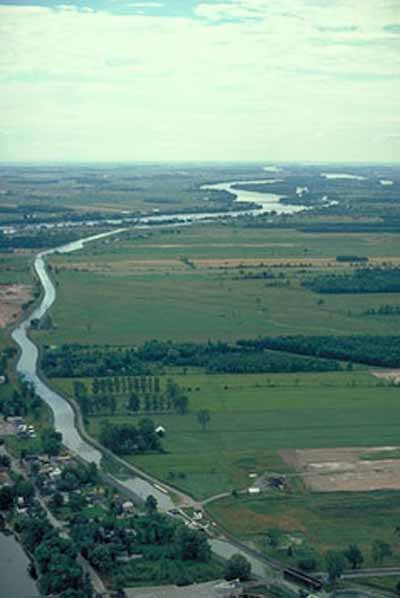Saint-Ours Canal National Historic Site of Canada
Saint-Ours, Quebec

Aerial view
© Parks Canada Agency/Agence Parcs Canada
Address :
2930 Patriot Road, Saint-Ours, Quebec
Recognition Statute:
Historic Sites and Monuments Act (R.S.C., 1985, c. H-4)
Designation Date:
1929-05-17
Dates:
-
1830 to 1833
(Construction)
-
1844 to 1849
(Significant)
-
1960 to 1969
(Significant)
-
1974 to 1974
(Significant)
Event, Person, Organization:
-
Board of Works of the United Canadas
(Organization)
Other Name(s):
-
Saint-Ours Canal
(Designation Name)
Research Report Number:
1987-A03-4
DFRP Number:
56462 00
Plaque(s)
Approved Inscription: 2930 Patriot Road, Saint-Ours, Quebec
Opened in 1849, this canal was an integral part of the vast network of navigable waterways built in Canada in the 19th century. Its lock and dam, along with the Chambly Canal upstream, allowed boats to navigate the Richelieu from the St. Lawrence to Lake Champlain, providing access to the Hudson River thus linking Montréal to New York City. At first, the canal played an important economic role by facilitating the export of goods, such as agricultural and forestry products, in exchange for American coal. During the 20th century, commercial navigation on the canal gradually gave way to pleasure boating.
Description of Historic Place
Saint-Ours Canal National Historic Site of Canada is situated on the east bank of the Richelieu River, 52 km from Chambly and 23 km from Sorel Québec. It is located in a 5-hectare park and primarily consists of one enclosed lock between the east bank of the Richelieu River and Darvard Island, as well as a dam.
Heritage Value
Saint-Ours Canal was designated a national historic site because: it is one of Canada's national canals, situated on the Richelieu River, it commemorates, together with the Chambly Canal, the role played by this navigation route in the 19th and 20th centuries as an inland system of canals linking Montréal to New York through the Richelieu River, Lake Champlain and the Hudson River.
The heritage value of Saint-Ours Canal lies in the inter-relationships of the components of its cultural landscape which have survived to this day: the Richelieu River, Darvard Island, the canal route, the dam, the buildings and archaeological remnants of canal activity. The Saint-Ours Canal was constructed by the Board of Works of the United Canadas as a commercial canal in 1844-1849, although the current lock dates from renovations in 1930-1933. Additional alterations occurred in 1960-1969 and 1974.
Source: Historic Sites and Monuments Board of Canada, Minutes, June 1987.
Character-Defining Elements
Key elements contributing to the heritage value of this site include:
the completeness of the canal's historic cultural landscape (which includes a portion of the Richelieu River, Darvard Island, the canal route, a dam, buildings and archaeological remnants of canal activity) and the historical inter-relationships between these components,
features of the present canal that provide tangible evidence of its historical use and evolution over time, particularly: the present lock situated between Darvard Island and the east bank, the canal route which forms a channel between the footprint of the lock, its walls, and its leading coffer dam, the regulating dam connecting the west bank of the river to Darvard Island, the parallelism existing between the footprints of the original canal and the present canal,
the fabric and forms of earlier canal and canal-related components that witness its route, technology and composition in earlier times, particularly: the footprint of the earlier canal, the remains of the first lock from which the historic lower entry to the canal is still visible, the relationship between early canal buildings (and their remains) and the canal itself.